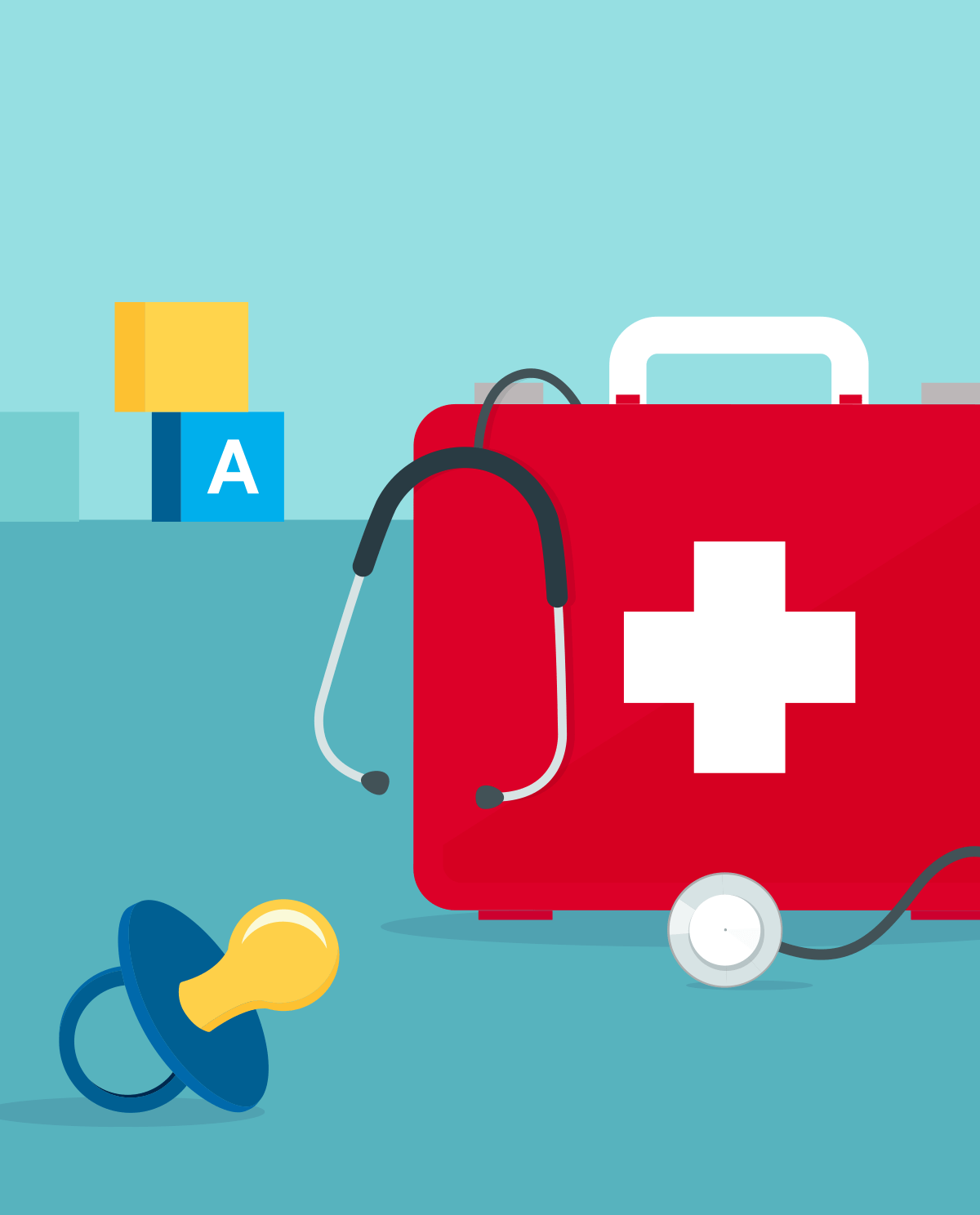Who should be able to give first aid?
Everyone, without exception, should learn basic first aid skills, especially parents, grandparents and childminders. While caring for small children, various types of accidents can happen, sometimes harmless, requiring only our intervention, sometimes very serious, when emergency assistance is needed. That is why it is so important not to spend time searching for knowledge online but rather to be able to help someone in need quickly and efficiently. In emergency situations, knowing what to do can make a huge difference when waiting for the emergency services to arrive.
What is first aid?
These are successive actions performed by a person at the scene of an accident to save a second person whose health or life is at risk.
The key principle that should be followed by the person providing assistance is to take care of their own safety - when something happens to the ‘rescuer’, they will not be able to help.
When giving premedical help to a child, the set of actions to be performed varies, depending on their age. We list three groups:
- infant - under 1 year old,
- child - over 1 year of age until reaching puberty,
- adult - children who have already reached puberty, and adults.
Choking
This is a condition in which the airways are obstructed by, for example, by a piece of food, or a small object swallowed by a child. There are two types of obstruction:
- partial - the airways are not closed, air flow is possible. The most common defensive reflex of the body is coughing.
- total - foreign matter in the respiratory tract closes the lumen of the duct and cuts off the access of air. In this case, the injured person is not able to speak, cough or breathe. Initially, the audible whistling of air in the airways calms down and the victim is exposed to loss of consciousness.
How can you help a choking infant?
In the event that the cough is effective, you only need to watch the child. If the child is conscious but not coughing or if the coughing is not effective, then:
- kneel and place the child on your forearm with the head facing downwards,
- hold the child’s lower jaw with your thumb and index finger, while tilting their head back and opening the airway (do not hold their neck!),
- perform 5 blows with the base of the wrist in the inter-shoulder area,
- after the impacts, check whether the foreign body has been removed from the respiratory tract or whether it is not in the mouth, from where it can be pulled out with a small finger.
If the above actions fail, you should:
- turn the infant on their back on the other forearm (head still down),
- embrace the baby's occiput with your hand,
- indicate the place to compress the chest (lower half of the sternum, 1 finger wide above the end),
- perform 5 chest compressions.
Then repeat both steps alternately (5 strokes and 5 compressions) until the foreign body is removed.
If the infant loses consciousness, resuscitation is required! Start with 5 breaths to push the foreign body deeper, even if it falls into one of the lungs, it will allow the other lung to breathe.
How do you help a child over 1 year old?
In the event that the cough results, you should only encourage the cough and watch the child. If the child is conscious but not coughing or coughing is not effective, then:
- stand behind the child,
- put your hand under the child's rib cage and bend them forward,
- 5 back blows with the heel of your hand should be administered into the inter-shoulder space,
- after each back blow, check whether the foreign body has been removed from the respiratory tract.
If the above actions fail, you should:
- stand behind the child and put your arms around their upper abdomen,
- lean the child forward
- put your fist, covered by the other hand, between the child’s navel and breastbone,
- press the epigastric region 5 times while moving inwards and upwards, without applying pressure to the rib cage.
Then repeat both steps alternately (5 strokes and 5 compressions) until the foreign body is removed.
If the child loses consciousness, resuscitation is required!
Cardiopulmonary resuscitation
When the child is unconscious and not breathing:
- open the airway by tilting the head back and raising the lower jaw,
- gently pull out any visible foreign bodies,
- make sure that the airways are open, unobstructed,
- perform 5 rescue breaths:
- mouth-to-nose in infants,
- mouth-to-mouth in children.
How to perform rescue breathing correctly.
- Get some air.
- Close your mouth around your child's mouth or child's mouth and nose.
- Blow air for 1 second until the chest rises.
- Check that the chest falls and make sure that the airway is clear.
- Perform 5 rescue breaths.
Up to 10 seconds after breathing and/or opening the airway, the first signs of cardiac restoration should appear:
- proper breathing,
- chest movements
- cough, sound
- any movement.
If the correct breathing has returned, place the child in a safe position and call an ambulance (unless someone has already done so).
If no breathing has appeared, notify emergency services and begin resuscitation. Lay the child/infant on his back on the ground, kneel at the height of their chest and reveal it (remove any clothes covering the chest area).
CPR (Cardiopulmonary resuscitation) in infants
- put 2 fingers around the lower half of the breastbone (in the middle of the chest),
- compress the chest, then release the pressure without lifting your fingers from the surface of the body,
- perform the actions in relation to: 15 compressions, 2 inhalations (if the rescuer is alone use a 30:2 ratio, especially if they have difficulty changing the position between oppression and ventilation).
CPR in children over 1 year old
- put your hand around the lower half of the breastbone (in the middle of the chest),
- straighten your arm at the elbow and place it perpendicular to the child's chest,
- compress the child's chest to about 1/3 of its depth (5 cm),
- try to keep the pace from 100 to 120 compressions/minute, i.e. around 2 compressions/second,
- perform the actions in relation to: 15 compressions, 2 inhalations (if the rescuer is alone, they can use the ratio of 30:2).
When can CPR be stopped?
- when the injured child begins to breathe properly, or move,
- in the event of exhaustion - another person should continue rescue operations,
- upon arrival of an ambulance, the rescuer will be able to replace the person performing the resuscitation.
Nosebleed
Quite a common phenomenon, especially in young people. In this situation:
- convince the child to sit down with the head extended and tilted forward,
- tighten both sides of the nose for 10 minutes,
- if blood runs down the throat, it should not be swallowed, it must be spat out,
- you can cool your child's neck and forehead with cold compresses.
Dealing with burns
In the event of a burn, the steps you should take are as follows:
- remove clothing from the burned area,
- rinse the wound thoroughly with running water or, if this is not possible, apply a hydrogel wrap,
- call for medical help or go to the hospital.
Emergency numbers (US)
- 911 - general emergency number
Emergency numbers (UK)
- 999 - general emergency number
- 112 - general emergency number (works worldwide)
Emergency numbers (Poland)
- 112 - general emergency number
- 999 - ambulance service
- 998 - fire brigade
- 997 - police
- Advanced resuscitation procedures in children - Polish Resuscitation Council - http://www.prc.krakow.pl/wyt2015/6_EPLS.pdf
- https://www.mp.pl/pacjent/pierwsza_pomoc/212584,pierwsza-pomoc-podrecznik
- https://www.mp.pl/pacjent/pierwsza_pomoc/212030,dzieci-ponizej-1-roku-zycia
- https://www.mp.pl/pacjent/pierwsza_pomoc/212031,dzieci-powyzej-1-roku-zycia
- http://www.edziecko.pl/zdrowie_dziecka/1,79374,8128401,Udzielanie_pierwszej_pomocy___na_wszelki_wypadek.html
- https://www.youtube.com/watch?v=oaOrvWGZsHg
- https://www.youtube.com/watch?v=-wajis2PA5g
- https://www.youtube.com/watch?v=jddpdxR751A









